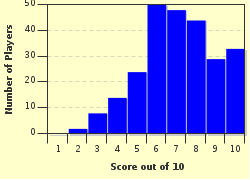Quiz Answer Key and Fun Facts
1. The equal loudness curve goes from the lowest audible sound to the level of the threshold of pain.
2. Music at a rock concert will cause temporary hearing loss, but no permanent damage occurs.
3. What are the primary parts of a typical loudspeaker?
4. What kinds of frequencies are too high to be heard by humans?
5. A "driver" is a device that reproduces sound. What are some examples of drivers?
6. In order for a sound to occur, the air at rest must vibrate between an at rest state, to a pressure state and then back to an at rest state, over and over.
7. "Ringing in the ears" can be a warning sign that the sound you are listening to is too loud.
8. Sound waves cause local variations in air pressure.
9. What are speaker cones made from?
10. The basket of a speaker serves what function?
Source: Author
mobunny
This quiz was reviewed by FunTrivia editor
crisw before going online.
Any errors found in FunTrivia content are routinely corrected through our feedback system.

